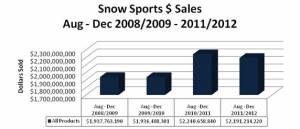McLean, VA – SnowSports Industries America (SIA) and The Leisure Trends Group on Thursday released the most recent numbers for December 2011, collected from the point of sale systems of more than 1,200 snow sports retailers across the U.S. According to the report, December’s lack of snow had significant impacts on the snow sports market as snow failed to fall in key regions across the country.
Snow cover across the contiguous 48 states fell from 48% in December 2010 to 23% in December 2011. Although the snow sports market suffered in December, sales remained above the four-season average and a mid-January change in the storm track may help the market recover across the entire 2011-12 season.

Snow Sports consumers were obviously affected by the lack of snow in December but demonstrated hope that winter was late to start rather than absent. Sales through December reached $2.2 billion, 2% below last season’s record sales but above August through December Sales in the 2008-09 and 2009-10 seasons. Sales between August and December were down 10% overall in units with pronounced decreases in accessories that consumers tend to buy on their way to the mountains including goggles, wax, and gloves.
Equipment and apparel sales normally purchased with the slopes and trails in mind but before the trek to the mountains begins fared better, with increased sales in major categories including alpine and AT/Randonée equipment and insulated tops. Specialty shop inventories were up 16% overall, clearly showing the lag in sales. Additionally, specialty shops sell-through was down 10% overall through December as consumers waited for more snow to fall.
Despite the declines, reverse and mixed camber ski sales are up an astounding 75% in units sold to 87,000 pairs sold, making up 23% of all alpine skis sold through December this season. Insulated parka sales are up 4% in units sold as non-participants head to chain stores and online to buy snow sports apparel as casual wear. Internet sales of insulated parkas are up 18% in units and 14% dollars sold through December.
In-season AT/Randonée boot sales are up 12% in units and dollars, and climbing skin sales are up 10% in units sold and 12% in dollars sold, demonstrating the trend toward backcountry-capable gear. Rocker snowboard sales account for more than 70% of all in-season snowboard sales this season with increases of 13% in units and 11% in dollars sold recorded through December.

Snow was a scarce commodity in December 2011. Snow sports sales suffered specifically in response to the lack of snow in December. In fact, most variance in snow sports sales can be directly attributed to weather. In December this season, snow sports participants were very dependent on man-made snow that has kept the market moving despite the snow drought that lasted until mid-January. In fact, snow cover was down more than 50% from levels in December 2010.
Hope remains, however, for better conditions this season; as of January 24, 41% of the country was snow covered, and snow is now falling in key regions across the country.

